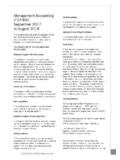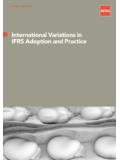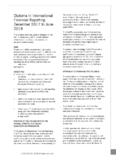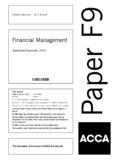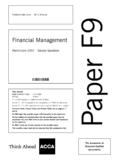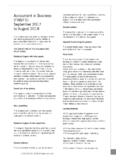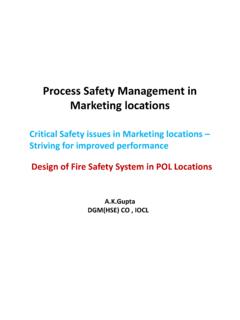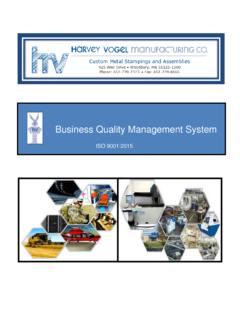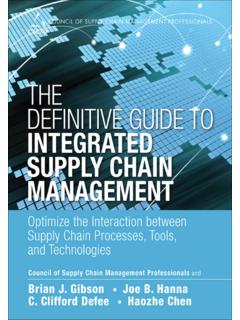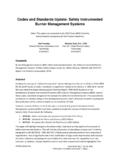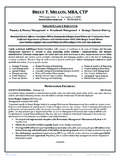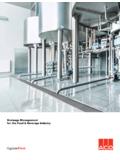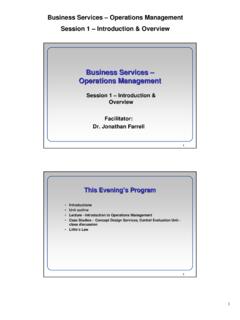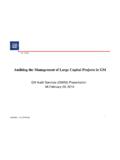Transcription of Performance Management - ACCA Global
1 Fundamentals Level Skills ModuleTime allowedReading and planning:15 minutesWriting:3 hoursALL FIVE questions are compulsory and MUST be Sheet is on page NOT open this paper until instructed by the reading and planning time only the question paper may be annotated. You must NOT write in your answer booklet untilinstructed by the question paper must not be removed from the examination F5 PerformanceManagementMonday 2 December 2013 The Association of Chartered Certified AccountantsALL FIVE questions are compulsory and MUST be attempted1 process Co has two divisions, A and B.
2 Division A produces three types of chemicals: products L, M and S, using acommon process . Each of the products can either be sold by Division A to the external market at split-off point (afterthe common process is complete) or can be transferred to Division B for individual further processing into productsLX, MX and SX. In November 2013, which is a typical month, Division A s output was as follows:ProductKgL1,200M1,400S1,800 The market selling prices per kg for the products, both at split-off point and after further processing, are as follows:$$L5 60LX6 70M6 50MX7 90S6 10SX6 80 The specific costs for each of the individual further processes are.
3 $Variable cost of $0 50 per kg of LXVariable cost of $0 70 per kg of MXVariable cost of $0 80 per kg of SXFurther processing leads to a normal loss of 5% at the beginning of the process for each of the products :(a) Calculate and conclude whether any of the products should be further processed in Division B in order tooptimise the profit for the company as a whole.(10 marks)(b)It has been suggested that Division A should transfer products L and M to Division B for further processing, inorder to optimise the profit of the company as a whole.
4 Divisions A and B are both investment centres and alltransfers from Division A to Division B would be made using the actual marginal cost. As a result, if Division A were to make the transfers as suggested, their divisional profits would be much lower than if it wereto sell both products externally at split-off point. Division B s profits, however, would be much :Discuss the issues arising from this suggested approach to transfer pricing. (5 marks)(c) process Co is becoming increasingly concerned that environmental costs may be increasing within the , the company has not yet developed a structured way for accounting for these costs.
5 It has heard of anumber of different Management accounting techniques which can be used to account for environmental costs,including input/output analysis , flow cost accounting , environmental activity-based costing and life cyclecosting .Required:Briefly describe TWO of these techniques in the context of environmental Management accounting.(5 marks)(20 marks)22 Solar Systems Co (S Co) makes two types of solar panels at its manufacturing plant: large panels for commercialcustomers and small panels for domestic customers.
6 All panels are produced using the same materials, machineryand a skilled labour force. Production takes place for five days per week, from 7 am until 8 pm (13 hours), 50 weeksof the year. Each panel has to be cut, moulded and then assembled using a cutting machine (Machine C), a mouldingmachine (Machine M) and an assembly machine (Machine A).As part of a government scheme to increase renewable energy sources, S Co has guaranteed not to increase the priceof small or large panels for the next three years. It has also agreed to supply a minimum of 1,000 small panels eachyear to domestic customers for this three-year to poor productivity levels, late orders and declining profits over recent years, the finance director has suggestedthe introduction of throughput accounting within the organisation, together with a Just in Time system of costs and selling prices for each type of panel are shown panelsSmall panels$$Selling price per unit12,6003,800 Material costs per unit4,3001,160 Total factory costs.
7 Which include the cost of labour and all factory overheads, are $12 million each year at the plant. Out of the 13 hours available for production each day, workers take a one hour lunch break. For the remaining 12 hours, Machine C is utilised 85% of the time and Machines M and A are utilised 90% of the time. Theunproductive time arises either as a result of routine maintenance or because of staff absenteeism, as each machineneeds to be manned by skilled workers in order for the machine to run. The skilled workers are currently only trainedto work on one type of machine each.
8 Maintenance work is carried out by external contractors who provide a roundthe clock service (that is, they are available 24 hours a day, seven days a week), should it be following information is available for Machine M, which has been identified as the bottleneck resource:Large panelsSmall panelsHours per unitHours per unitMachine M1 40 6 There is currently plenty of spare capacity on Machines C and A. Maximum annual demand for large panels and smallpanels is 1,800 units and 1,700 units :(a) Calculate the throughput accounting ratio for large panels and for small panels and explain what theyindicate to S Co about production of large and small panels.
9 (9 marks)(b)Assume that your calculations in part (a) have shown that large panels have a higher throughput accounting ratiothan small panels. Required:Using throughput accounting, prepare calculations to determine the optimum production mix and maximumprofit of S Co for the next year.(5 marks)(c) Suggest and discuss THREE ways in which S Co could try to increase its production capacity and henceincrease throughput in the next year without making any additional investment in machinery.(6 marks)(20 marks)3[ Co produces microphones for mobile phones and operates a standard costing system.]
10 Before productioncommenced, the standard labour time per batch for its latest microphone was estimated to be 200 hours. Thestandard labour cost per hour is $12 and resource allocation and cost data were therefore initially prepared on thisbasis. Production of the microphone started in July and the number of batches assembled and sold each month was asfollows:MonthNo of batches assembled and soldJuly1 August1 September2 October4 November8 The first batch took 200 hours to make, as anticipated, but, during the first four months of production, a learningeffect of 88% was observed, although this finished at the end of October.
